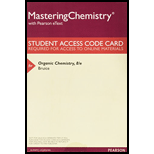
Concept explainers
(a)
Interpretation: The product of Perkin condensation has to be written
Concept introduction: For the given condensation reactions,
In first case, acetic anhydride is treated with a base and a proton is abstracted. The enolate ion thus formed attacks carbonyl carbon of benzaldehyde. Loss of water molecule results in the formation of the product of Perkin condensation.
In second case, water is added to the product of Perkin condensation and it causes hydrolysis of the ester to form an acid.
In third case, diethyl malonate is treated with a base and enolate ion is formed. Enolate ion attacks a molecule of benzaldehyde and forms an intermediate species. Loss of a water molecule results in the formation of the product of Knoevenagel reaction.
In fourth case, the product of Knoevenagel reaction on acidic hydrolysis gives carboxylic acid and on heating undergoes decarboxylation.
(b)
Interpretation: The compound formed after addition of water to the product of Perkin condensation has to be written.
Concept introduction: For the given condensation reactions,
In first case, acetic anhydride is treated with a base and a proton is abstracted. The enolate ion thus formed attacks carbonyl carbon of benzaldehyde. Loss of water molecule results in the formation of the product of Perkin condensation.
In second case, water is added to the product of Perkin condensation and it causes hydrolysis of the ester to form an acid.
In third case, diethyl malonate is treated with a base and enolate ion is formed. Enolate ion attacks a molecule of benzaldehyde and forms an intermediate species. Loss of a water molecule results in the formation of the product of Knoevenagel reaction.
In fourth case, the product of Knoevenagel reaction on acidic hydrolysis gives carboxylic acid and on heating undergoes decarboxylation.
(c)
Interpretation: The product of Knoevenagal condensation has to be written
Concept introduction: For the given condensation reactions,
In first case, acetic anhydride is treated with a base and a proton is abstracted. The enolate ion thus formed attacks carbonyl carbon of benzaldehyde. Loss of water molecule results in the formation of the product of Perkin condensation.
In second case, water is added to the product of Perkin condensation and it causes hydrolysis of the ester to form an acid.
In third case, diethyl malonate is treated with a base and enolate ion is formed. Enolate ion attacks a molecule of benzaldehyde and forms an intermediate species. Loss of a water molecule results in the formation of the product of Knoevenagel reaction.
In fourth case, the product of Knoevenagel reaction on acidic hydrolysis gives carboxylic acid and on heating undergoes decarboxylation.
(d)
Interpretation: A compound formed after product of Perkin condensation is heated in an acidic medium has to be written
Concept introduction: For the given condensation reactions,
In first case, acetic anhydride is treated with a base and a proton is abstracted. The enolate ion thus formed attacks carbonyl carbon of benzaldehyde. Loss of water molecule results in the formation of the product of Perkin condensation.
In second case, water is added to the product of Perkin condensation and it causes hydrolysis of the ester to form an acid.
In third case, diethyl malonate is treated with a base and enolate ion is formed. Enolate ion attacks a molecule of benzaldehyde and forms an intermediate species. Loss of a water molecule results in the formation of the product of Knoevenagel reaction.
In fourth case, the product of Knoevenagel reaction on acidic hydrolysis gives carboxylic acid and on heating undergoes decarboxylation.
Want to see the full answer?
Check out a sample textbook solution
Chapter 17 Solutions
Organic Chemistry - MasteringChemistry
- Explain the following reactions giving one example in each : (i) Cross Aldol condensation(ii) Cannizzaro reaction(iii) Decarboxylation reaction(vi) Kolbe’s reaction(v) Hell-Volhard-Zelinsky reactionarrow_forwardAldol Condensation What products are formed? What is the difference between aldol reactions and aldol condensation? What type of reaction condentionas are used?arrow_forwardWhat is the starting material for this product of a intramolecular aldol condensation reaction?arrow_forward
- What is the best reaction to form a beta-ketone? 1. Aldol-Claisen Condensation 2. Aldol-Claisen Addition 3. Aldol Condensation 4. Claisen Condensationarrow_forwardYour aldol condensation procedure calls for refluxing vanillin in acetone and NaOH for an hour. Whatmight happen if you didn’t heat the reaction, or heated it for too short a time? a) A mixture of aldol products and hydroxyketone intermediates would form.b) No reaction would occur, as the heat is needed to deprotonate the acetone.c) The reaction would still be successful.d) No reaction would occur, as the heat is needed to dissolve the NaOH.arrow_forwardThe aldol double condensation reaction is highly selective for formation of a single double condensation product. Explain why only one aldol condensation product is formed despite two carbonyl compounds being present for the reaction.arrow_forward
- Explain why a Lewis acid is necessary in this aldol reaction. Include a structure formed by the Lewis Acid and one of the reactants that is key to your discussion. R group is p-methoxyphenyl to make p-methoxybenzaldehyde (reactant). R' is phenyl.arrow_forwardWhich will form enolates?1. Aldol condensation2. Tranesterification 3. Dieckmann condensation 4. Claisen Condensationarrow_forwardWhat is the best combination to create a beta-dicarbonyl (1,3-dicarbonyl) compound? a) enolate + aldehyde b) enolate + acid derivative c) enolate + alpha-halogenated carbonyl d) enolate + conjugated carbonyl (Michael addition)arrow_forward
- The synthesis of carbohydrates can be particularly difficult because of the large number of chiral centers and OH functional groups present. Epoxides can be useful synthetic intermediates in carbohydrate syntheses. Draw the product of the following reaction of a Gilman reagent with each epoxidearrow_forwardDraw out the machanism for the aldol condensation of (2E,6E)-2,6-bis(4-ethylbenzylidene)cyclohexanone. (the reaction between cyclohexanone and 4-methoxybenzaldehyde)arrow_forwardDraw the aldol product formed from each compound.arrow_forward
 Organic Chemistry: A Guided InquiryChemistryISBN:9780618974122Author:Andrei StraumanisPublisher:Cengage Learning
Organic Chemistry: A Guided InquiryChemistryISBN:9780618974122Author:Andrei StraumanisPublisher:Cengage Learning
